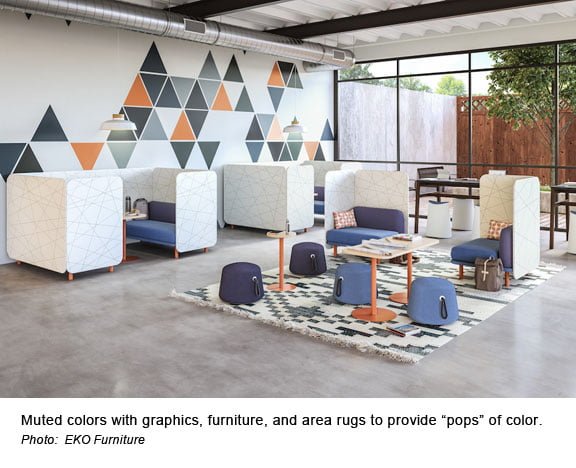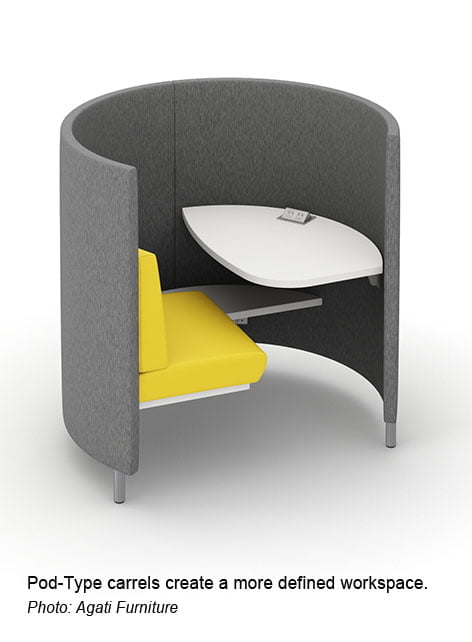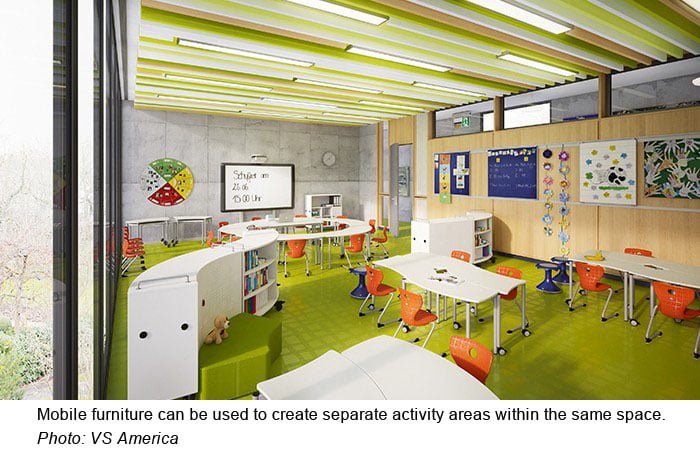Seeking Solitude in the 21st-Century Classroom
While attending a symposium on learning environments, I heard the familiar jargon bantered about: “group learning,” “collaborative learning,” and, “project-based learning.” These are current methods of instruction being employed in spaces referred to variously as “collaboratories,” “makerspaces,” and the “21st-Century classroom.” I, however, was caught off guard by a term that I hadn’t heard in this context before: the “cave.” A cave is a quiet space where a single student can go to work alone. Wait a minute; how does the cave fit in with these group activities? Aren’t students supposed to work together, sharing ideas and learning to be part of a team? Yes. But, as we know, everyone needs some quiet time.
As educators, designers, furniture manufacturers, and others involved in education moved in the direction of the collaborative 21st Century classroom, it became apparent that not all students were able to thrive in this type of environment. Not everyone likes to work in groups on a constant basis. For various reasons, some students can only tolerate this for a limited amount of time. Some are too distracted by the levels of noise and activity often encountered when groups work together in open spaces. Some learn more effectively on their own in quieter, orderly environments. Others could be introverted.
Introversion and introverts have become a popular topic of late, brought to the forefront by Susan Cain’s best-selling book Quiet: The Power of Introverts in a World That Can’t Stop Talking. In her book, Cain discusses the emphasis on the needs of extroverts over those of introverts. Without going into detail, high value is placed on the personality traits of extroverts, and introverts are encouraged to emulate them. Yet, Cain doesn’t see the introverted personality type as a disadvantage or as an affliction to be cured; it’s simply different, and of equal value. Additionally, in an article for The Atlantic magazine, writer and English teacher Michael Godsey cites examples of students who did poorly in schools where the classrooms were noisy and full of distractions did significantly better when attending schools with quieter, more structured classrooms. These students were not necessarily introverts; they were easily distracted.
So, where does this leave us? Do we abandon the various methods of group learning? Do we abandon the contemporary, flexible classrooms that accommodate varied activities in favor of row upon row of individual desks that never move once put in place? No. The answer, of course, is somewhere in the middle and extends beyond furniture.
 In Introversion in the Classroom: How to Prevent Burnout and Encourage Success, Jessica Honard, M.ED, highlights some of the characteristics of the classroom environment preferred by both introverts and extrovert. According to Honard, while introverts prefer spaces with subdued colors that are orderly, uncluttered and relatively peaceful with limited social interaction, extroverts prefer vibrantly colored spaces that are livelier and allow for more social interaction. To remedy this, she recommends creating an environment that finds middle ground. This might sound difficult, considering these spaces are somewhat polar opposites. However, here are some thoughts to facilitate the creation of a classroom to address the needs of both personality types.
In Introversion in the Classroom: How to Prevent Burnout and Encourage Success, Jessica Honard, M.ED, highlights some of the characteristics of the classroom environment preferred by both introverts and extrovert. According to Honard, while introverts prefer spaces with subdued colors that are orderly, uncluttered and relatively peaceful with limited social interaction, extroverts prefer vibrantly colored spaces that are livelier and allow for more social interaction. To remedy this, she recommends creating an environment that finds middle ground. This might sound difficult, considering these spaces are somewhat polar opposites. However, here are some thoughts to facilitate the creation of a classroom to address the needs of both personality types.
Selecting colors can be a bit tricky but consider using neutral colors with carefully-placed accents of brighter colors. The accents need not be grand gestures, such as an entire wall brightly colored, but they can be as simple and as subtle as door frames, architectural trim and furniture pieces. Floor finishes are a bit more difficult since they can’t necessarily be moved within the space. However, vibrantly colored area rugs, matts, tackable wall surfaces and other “portable” finishes can meet the need.
Hard surfaces always seem to lead to acoustical problems in the classroom. The typical classroom is bounded by acoustically reflective materials on nearly every surface with the exception of the acoustical ceilings. The addition of the afore-mentioned area rugs and tackable surfaces will help to keep the noise at reasonable levels, as will the occasional reminder to use “inside voices.”
The “cave” in a classroom need not be the literal interpretation
of a  walled-off space, nor does it require furnishings such as pod-type study carrels – this is not to say that they can’t be, either. Cave spaces can easily be established with existing classroom furnishings and a little creativity. One recent client, for example, made a “reading cave” in his 4th grade classroom simply by draping a sheet over a table to enclose the space below and placing an area rug and throw pillows beneath the table. One side is open, allowing him to monitor the student using it. Another instructor in the same independent school created a cave that is more open by placing soft seating in a corner of the room and placing a mobile bookcase at one of the remaining two sides. If your budget allows for furniture, carrels such as Agati’s “Pod” provide visual and acoustical privacy without complete isolation.
walled-off space, nor does it require furnishings such as pod-type study carrels – this is not to say that they can’t be, either. Cave spaces can easily be established with existing classroom furnishings and a little creativity. One recent client, for example, made a “reading cave” in his 4th grade classroom simply by draping a sheet over a table to enclose the space below and placing an area rug and throw pillows beneath the table. One side is open, allowing him to monitor the student using it. Another instructor in the same independent school created a cave that is more open by placing soft seating in a corner of the room and placing a mobile bookcase at one of the remaining two sides. If your budget allows for furniture, carrels such as Agati’s “Pod” provide visual and acoustical privacy without complete isolation.
 Different activities; differing personality types; and both in the same room at the same time. Mobile furniture can establish areas for different uses while maintaining the cohesiveness of the classroom.
Different activities; differing personality types; and both in the same room at the same time. Mobile furniture can establish areas for different uses while maintaining the cohesiveness of the classroom.
Solitude can be found in the 21st Century classroom. With some forethought about student needs, the planned methods of educating them, and the layout of the classroom, various activities, and personality types can be accommodated. Flexibility is maintained so that group and project-based learning can be accomplished in a dynamic space without overwhelming introverted students.

